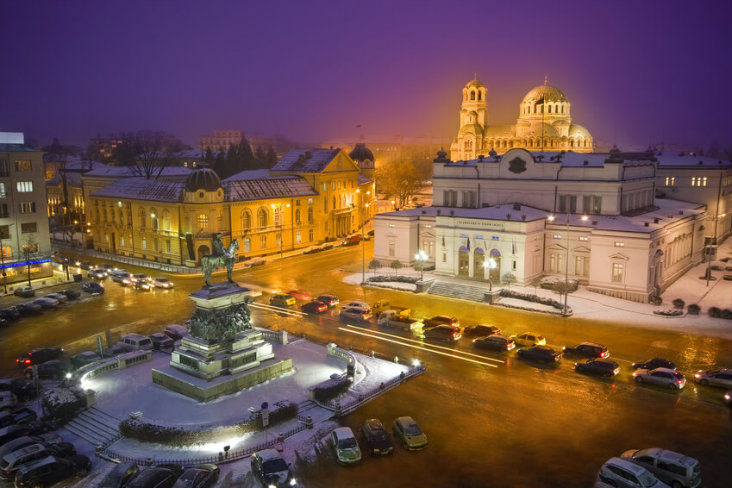Bulgaria Capital
If you are looking to visit a vibrant city with rich history, ancient sites, majestic temples, nearby mountain and stunning nature, excellent nightlife, exciting cultural venues, welcoming people and delicious food and wine, Sofia - the Bulgarian capital - is the place for you!
Sofia also happens to be one of the most affordable cities in Europe, which means that your visit to the ancient Bulgarian capital will not break the bank. What else could you ask for?! Read on about Sofia’s most popular attractions, entertainment, cuisine and some tips on how to make the most of your stay in Bulgaria's capital.
Bulgaria's capital - one of Europe's oldest cities
Sofia (Bulg. София), located at the crossroads of Europe and Asia, is the 2nd oldest city in Europe, dating back to Roman times when it was called Serdica. Since around 29 BC, Serdica gradually flourished and become a major Roman city in the region. In the Middle Ages, the city changed its ownership a couple of times between the Bulgarians and the Byzantine Empire until 1382, since when it was under Ottoman rule for almost 500 years. Today's reminders of the Turkish oppression are Sofia's mosques. Finally, when the city gained independence from the Ottoman Empire, Sofia became the Bulgarian capital in 1879. WWII caused a lot of damage to Sofia, thus post-war Soviet-style appearance is noticeable around the city until today.
Bulgaria's capital - what to see and do in Sofia?
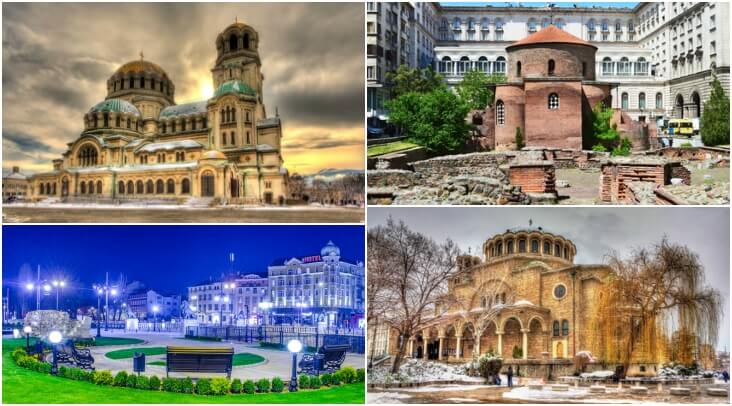
No matter what your interests are, you're unlikely to ever be bored in Sofia. Below is the list of some of the most interesting attractions and venues in the Bulgarian capital.
Bulgaria's capital: must-see historical sites and museums
Sofia is Bulgaria's cultural center with a variety of museums and galleries, from ancient traditional collections to modern exhibitions, and numerous churches.
- St. Alexander Nevski Memorial Church - the most impressive site and symbol of Sofia with its majestic golden domes. It is the largest church in Balkans, built to honor soldiers who lost their lives fighting for Bulgaria's freedom in the Russo-Turkish war in the 19th century. In the Aleksander Nevski Crypt (part of the church), there is the Museum of Icons which boasts the best religious icon collection in Bulgaria, with some pieces dating back to the 5th century. Admission: church - free entry; museum: 6 lv adults (3 lv students);
- Sveta Nedelya Cathedral - Eastern Orthodox medieval church that suffered from extensive damages over centuries and has been reconstructed numerous times; now one of Sofia's landmarks with its huge dome. The typical example of neo-Byzantine architecture. Admission: free;
- Boyana Church - UNESCO World Heritage site, located at the foot of Vitosha Mountain, south of Sofia center. Built-in the Middle Ages, this tiny church boasts 90 murals - exceptionally significant Bulgarian pieces of medieval art. Admission: 10 lv adult (1 lv student); guide fee - 10 lv;
- The Royal Palace - the former palace boasts two museums: the National Art Gallery and Ethnographical Museum. The gallery displays more than 3,000 exhibits, which are some of Bulgaria's most important collections of art pieces, including paintings, sculptures, and photographs. The museum exhibits traditional costumes, crafts, and folklore. Admission: gallery - 6 lv adult (3 lv student); museum - 3 lv adult (1 lv student);
- National Archaeological Museum - Bulgaria's oldest museum, located in a former Ottoman mosque. It displays an impressive collection of Thracian, Roman and medieval artifacts. Admission: 10 lv adult (2 lv student);
- National Museum of Military History - displays weapons, uniforms, flags, and artifacts from day-to-day life. While the garden outside exhibits Soviet-made tanks, planes, missile launchers, etc., dating back to the 20th century. Admission: 3 lv.
Excursions from Sofia to nearby attractions
Bulgaria's capital: parks and nature escapes
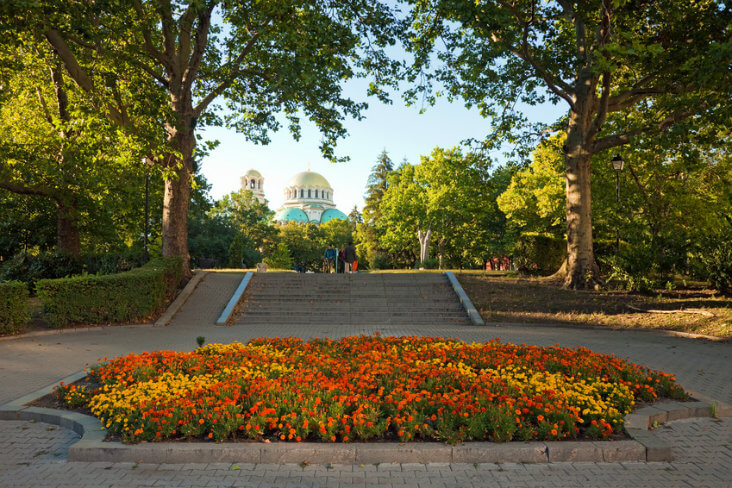
Sofia's large parks and manicured gardens are great places to escape from fast-paced city life, relax and recharge in natural surroundings.
- Borisova Gradina - the largest city park in Bulgaria and the most attractive in Sofia. A perfect place for a relaxing walk; it features numerous communist statues, flowerbeds, tennis court, stadiums, cafes and kid's playground;
- Yuzhen Park (South Park)- invites for a relaxing stroll on pleasantly shady paths amidst trees, stream and a few hidden bars and cafes;
- Vitosha Mountain - if you want to escape traffic and crowds, head to this peaceful forested park for a picnic, relaxing walk, day hike, cycling, or even skiing in the winter. It is only 20 minutes away by bus from Sofia's downtown. The mountain lies in the Vitosha Nature Park - the oldest nature park in Bulgaria - which boasts numerous marked trails, a handful of accommodation (hotels, chalets, huts), cafes, restaurants, and skiing trails (in winter).
Bulgaria's capital: cultural venues and nightlife
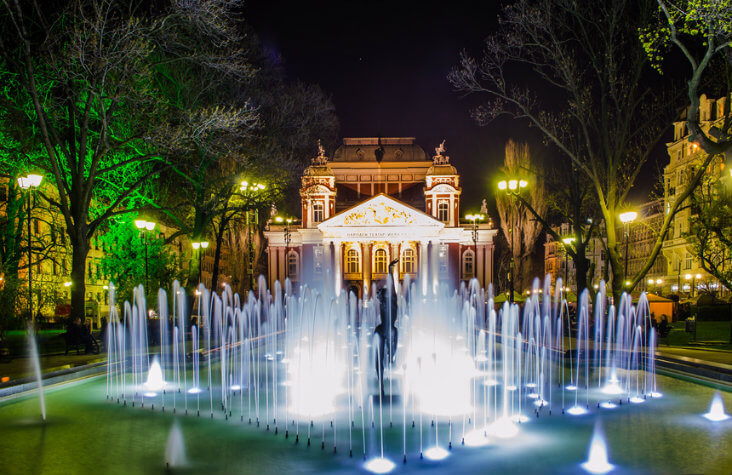
When you are done with a day of sightseeing, there is a time for some more fun at a wide range of venues that Sofia has to offer.
- Ballet or opera at the National Opera and Ballet of Bulgaria (http://www.operasofia.bg);
- Show in one of the Sofia Theatres e.g. Ivan Vazov National Theatre;
- Classical music concert in the National Palace of Culture;
- Numerous music clubs playing jazz, rock or piano bars e.g. Royal Piano Club;
- If you are a party type, end your day in one of the great nightclubs or discotheques e.g. Club Mascara, Bedroom Premium Club and more.
Bulgaria's capital: where to eat?
Sofia offers the most diverse and best food experience in Bulgaria. You can indulge in delicious traditional Bulgarian food, local pastries, and snacks, market-fresh produce, or try other foreign cuisines e.g. Moroccan, Greek, French, etc.
- For the best Bulgarian food experience, have a meal in one of the Sofia taverns. In addition to the authentic Bulgarian food and wine, you will experience folk music, songs and dances e.g. Chevermeto, Manastirska Magernitsa, or Hadjidraganov’s Houses;
- If you want a quick and cheap bite then try Soupateria, Divaka or Ma Baker;
- For fresh fruit or veggies, head to the bustling Ladies Market - the biggest fresh produce market in Sofia.
Visiting Bulgarian capital - useful tips
- If you arrive by plane to Sofia Airport, the metro is a fastest and cheapest way to get to Sofia center: a single ticket costs 1.60 lv (0.8 euro) and the journey takes less than 20 minutes;
- Accommodation rates in Sofia tend to be lower during summer months due to the smaller number of business travelers;
- Twice a day, there is a free Sofia-downtown walking tour (2 hours long) with volunteer English speaking guides from Free Sofia Tour: www.freesofiatour.com;
- More information about Sofia: www.sofia-guide.com
- Useful interactive map of Sofia in English: www.bgmaps.com/map/sofia
Weather Conditions in Sofia
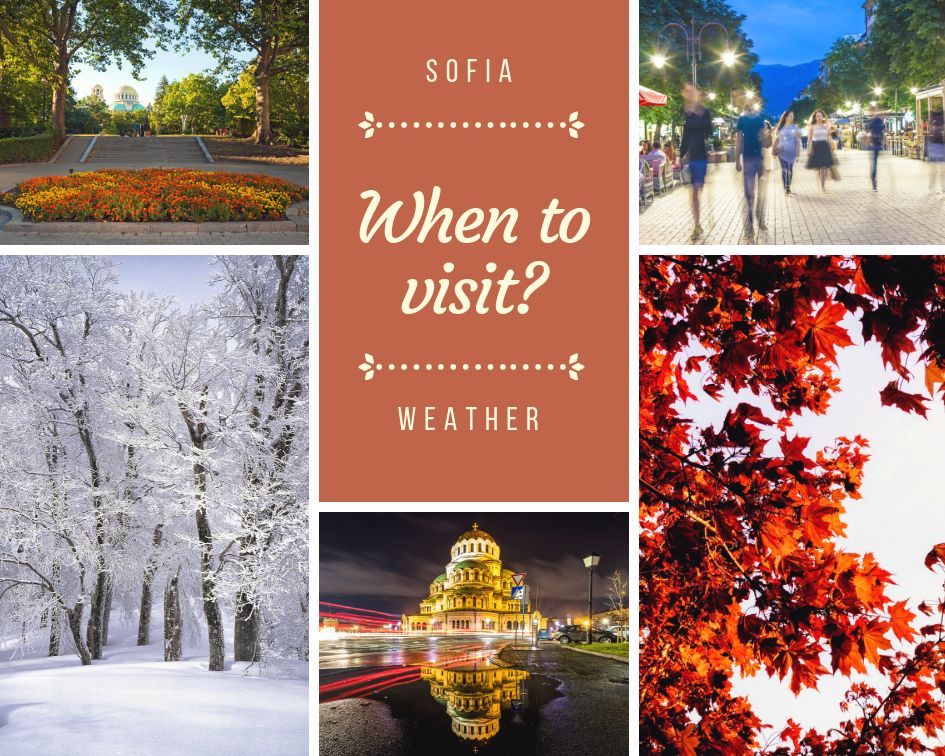
Sofia is a European city with a very rich history and serves as the capital of Bulgaria. The city is a perfect combination of two contrasting worlds: the old and the new one.
You can admire various types of architecture – from over a hundred years old historical buildings to modern design creations. Sofia is a hub of Bulgarian culture and nightlife. Numerous concerts, spectacles, theatre plays, and other events take place in the city every month.
Be prepared for any weather conditions though, especially if you decide to visit during the winter. Sofia is situated far away from the Black Sea and has a continental climate, meaning that winters can be quite harsh sometimes.
Summer in Sofia, Bulgaria
Summers in Sofia can be scorching, but due to the altitude of 550 meters above the sea level, the average temperature stays around 28 - 30°C during the day.
Many people choose to flee the concrete jungle for the seaside during the hottest months. However, Sofia is beautiful in the summer and you get the luxury of enjoying this ancient city without crowds in a more relaxed environment.
Temperatures quite often exceed 30°C and this is when you should be prepared to hide from the burning sun. Luckily for visitors, Sofia boasts many parks, gardens, coffee shops and bars to spend the afternoon. You can also cool down at the nearby Vitosha Mountain and take a nice stroll in shady woods. Contrary to the popular trend, coastal cities are not the only summer vacation spots in Bulgaria.
Winter in Sofia, Bulgaria
Winters in Sofia are always white and provide good conditions for skiing and snowboarding. Temperature is usually around 0°C or lower. Sadly, with short winter days, there aren’t many hours of sunshine to enjoy, but Sofia has less rainy days in winter compared to warmer seasons.
You can enjoy some winter sports at the nearby Vitosha mountain which is only 30 minutes away by bus. It means you will still have some time left to relax, even after a long day in the snow. Don’t worry, even in winter, Sofia is a lively city with a wide range of activities. Visiting art galleries, theatres, concert venues, restaurants, and other places is still possible as snow is removed on a regular basis, so you can easily explore the magnificent capital of Bulgaria.
Spring and Autumn in Sofia, Bulgaria
The autumn and spring have favorable weather conditions but they can change quickly. Temperatures are higher nearer the summer and lower nearer the winter season.
Spring will welcome visitors with average high temperatures of 10 - 15°C. The middle of May indicates the beginning of the summer season. However, the average low temperatures can be quite chilly even in May – starting from 0°C up to 9 - 10°C.
The autumn season is defined by big temperature drops down to 17°C in October and 10°C in November. Nighttime is quite cold during these months with average lows of 6°C and 1°C respectively. Rainfall is more common in the spring than in the autumn. The annual rain peaks in May, and sometimes in April. Despite the rainy weather, hours of sunshine are much more prominent in May compared to October.
|
Month |
Avg. Temp. |
Avg. High |
Avg. Low |
Rainy Days |
Sun Hours |
|---|---|---|---|---|---|
|
January |
-1 |
2 | -4 |
8 |
1 |
|
February |
1 |
4 |
-3 |
7 |
2 |
|
March |
6 |
10 |
1 |
11 |
3 |
|
April |
10 |
15 |
5 |
17 |
4 |
|
May |
15 |
20 |
9 |
17 |
9 |
|
June |
19 |
24 |
13 |
14 |
12 |
|
July |
21 |
28 |
14 |
11 |
11 |
|
August |
20 |
26 |
14 |
10 |
10 |
|
September |
17 |
23 |
11 |
10 |
6 |
|
October |
11 |
16 |
6 |
11 |
4 |
|
November |
5 |
8 |
1 |
11 |
2 |
|
December |
1 |
4 |
-2 |
8 |
1 |


